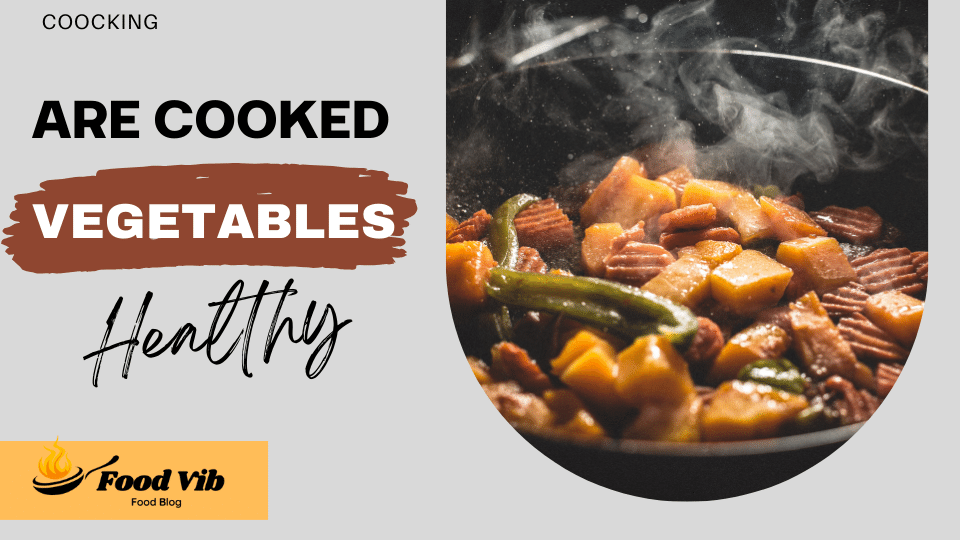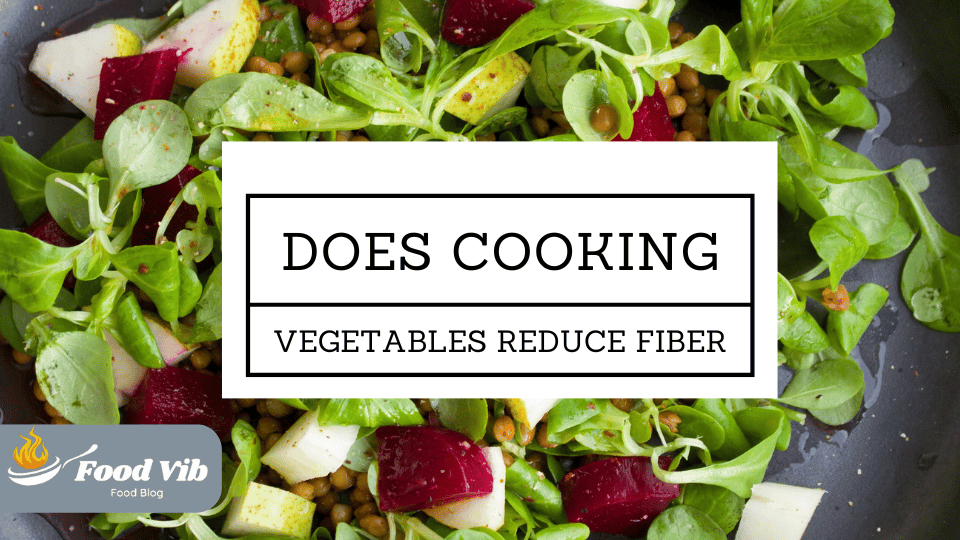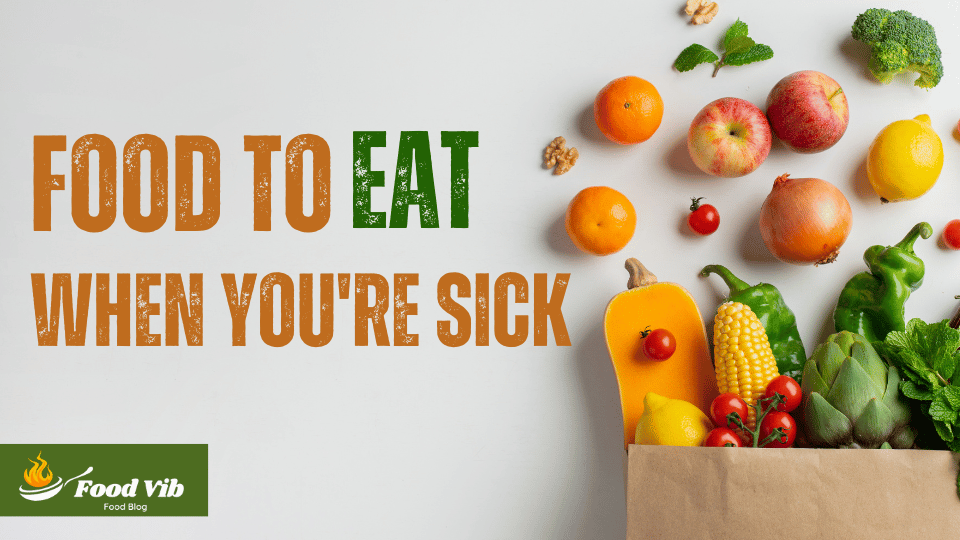Are Cooked Vegetables Healthy

Cooked vegetables are often praised for their health benefits, but just how healthy are they? Many people wonder are cooked vegetables healthy and their nutritional value. However, research has shown that cooked vegetables can still provide a wide range of nutrients and can even have some advantages over raw vegetables.
In this article, we will explore the health benefits of cooked vegetables and dispel any myths about their supposed lack of nutrition. So, let’s dive in and discover the truth about these delicious and nutritious foods!

Are Cooked Vegetables Healthy:
You might have heard that raw greens are always better than cooked ones. While there’s some truth to that, the answer isn’t so black and white. Cooked veggies can definitely be healthy and offer some unusual benefits:
Making Nutrients More Available:
Cooking can actually make some nutrients in veggies easier for your body to absorb. This is especially true for certain vitamins and antioxidants, like beta-carotene (found in carrots) and lycopene (found in tomatoes).
Softening Tough Veggie:
Some veggies, like broccoli or Brussels sprouts, can be tough to chew fresh. Cooking them breaks their cell walls, making them easier to digest and enjoy. This can be especially helpful for people with stomach problems.
Boosting Digestibility:
Cooking breaks down some complicated sugars and proteins in veggies, making them easier for your gut to handle. This can be helpful for people with weak tummies or certain intestinal problems.
More Variety, More Benefits:
Cooking opens up a whole world of options, allowing you to enjoy vegetables in different ways – roasted, steamed, stir-fried, or even in delicious soups and stews. This type helps you add more veggies into your diet, which is key to good health.
The Key, Gentle Cooking:
While cooking offers some benefits, it’s important to be aware of how you prepare your veggies. Avoid overcooking or using extra oil or butter, as this can kill nutrients and add needless calories. Opt for gentle cooking methods like steaming, baking, or stir-frying for the best results.
Must Read: How to Cook Canned Vegetables
Step by Step the Healthy Way of Cooking Vegetables:
Cooking veggies in a healthy way can help preserve their nutrients and tastes. Here’s a step-by-step guide to cooking veggies the healthy way:
1. Choose your cooking method:
- Steaming: This is the gentlest and best way to cook veggies. It uses minimal water and keeps most nutrients, taste, and color. Simply place your veggies in a steamer basket over boiling water and cook until tender-crisp.
- Roasting: Roasting brings out the natural sweetness of veggies. Toss them with some olive oil, herbs, and spices, and spread on a baking sheet. Roast at a high temperature (around 400°F) until soft and slightly browned.
- Stir-frying: This quick and easy method is great for soft veggies. Use a small amount of oil and cook the veggies over high heat until just cooked through.
2. Prep your veggies:
- Wash your veggies thoroughly. You can peel them if wanted, but know that some nutrients are found in the skin.
- Cut them into similar-sized pieces for even cooking. Smaller pieces will cook faster, so change according.
3. Cook them right:
- Don’t overcook: This is the biggest enemy of healthy veggie cooking. Overcooked veggies lose their proteins, structure, and bright color. Aim for tender-crisp, where they can still be easily cut with a fork but have a small bite.
- Use minimal water: When heating or cooking, use just enough water to barely cover the bottom of the pan. This helps preserve nutrients and taste.
- Season simply: Enhance the natural flavor of your veggies with herbs, spices, a squeeze of lemon or lime juice, or a drop of olive oil. Avoid adding excessive salt or butter, as they can contribute to bad fats and sodium intake.
Must Read: Angel Food Cake Lemon Pie Filling
7 Easy and Healthy Recipes for Cooked Vegetables:
These recipes are great for busy weeknights or weekend brunches, and they’re sure to please even the pickiest eaters. From baked veggies to veggie-packed soups and stir-fries, there’s something for everyone.
So grab your favorite veggies and get cooking! Here’s a sneak peek at what you’ll find:
1. Easy Roasted Mixed Vegetables:
Ingredients:
- Assorted veggies (such as carrots, bell peppers, zucchini, broccoli, and cauliflower)
- Olive oil Salt
- Pepper Herbs (optional, such as rosemary or thyme)
Methods:
1. Preparation:
- Preheat your oven to 400°F (200°C).
- Wash and chop the veggies into bite-sized pieces. You can mix and match any veggies of your choice according to your taste.
2. Seasoning:
- In a big bowl, toss the chopped veggies with olive oil. The olive oil helps to coat the veggies evenly and promotes caramelization during cooking.
- Season the greens with salt, pepper, and your choice of spices. This adds flavor and improves the taste of the cooked veggies. Herbs like rosemary or thyme complement the veggies nicely.
3. Roasting:
- Spread the seasoned veggies in a single layer on a baking sheet. It’s important not to overcrowd the baking sheet to ensure even cooking and burning.
- Place the baking sheet in the prepared oven and roast the veggies for 20-25 minutes. Keep an eye on them and stir halfway through the cooking time to ensure they roast evenly on all sides.
4. Checking for Doneness:
- After 20-25 minutes, check the veggies for doneness. They should be soft and slightly browned around the edges. You can put a fork or knife into the veggies to check for softness.
5. Serve and Enjoy:
- Once the vegetables are cooked to perfection, take them from the oven and transfer them to a serving dish.
- You can serve the roasted mixed vegetables hot as a side dish alongside your favorite main meal. They also make a great addition to salads, wraps, or grain bowls.
- Garnish with fresh herbs or a drizzle of balsamic glaze for an extra burst of flavor and visual appeal.
Tips:
- Use a variety of colored veggies to make your roasted food visually appealing and healthy.
- Don’t hesitate to try with different spices and herbs to adjust the taste of your roasted veggies.
- Ensure that the veggies are cut into similar-sized pieces for even cooking.
- Leftover roasted vegetables can be kept in a sealed container in the refrigerator for a few days and warmed when needed.
2. Stir-Fried Garlic Green Beans:
Ingredients:
- Green beans
- Garlic cloves, chopped
- Soy sauce
- Sesame oil
- Salt
- Crushed red pepper flakes (optional)
Method:
Prepare the Green Beans: Start by making the green beans. Wash them fully under cold water and then trim off the ends.
Heat the Skillet: Place a pan or wok on the stove over medium-high heat. Allow it to heat up for a minute or two.
Add Sesame Oil and Garlic: Once the pan is hot, add a drop of sesame oil. Let it heat for a few seconds, then add the minced garlic to the pan.
Sauté Garlic: Stir the garlic constantly with a spoon to prevent it from burning. Sauté it until it becomes fragrant and starts to turn golden brown, which usually takes about a minute.
Add Green Beans: Carefully add the clean and clipped green beans to the pan. Be careful, as the oil may splatter a bit when adding the green beans.
Stir-Fry Green Beans: Use tongs or a spatula to toss the green beans in the pan, ensuring that they are covered with the garlic and sesame oil. Keep turning and moving the green beans occasionally to cook them evenly.
Season with Soy Sauce: After the green beans have been cooking for about 5-7 minutes and have started to become tender-crisp, add a splash of soy sauce to the pan. This gives depth of flavor and a touch of saltiness to the dish.
Optional Spices: If you like a bit of heat, you can add in some crushed red pepper flakes at this point. Adjust the amount according to your taste for heat.
Final Seasoning and Tossing: Taste a green bean to check for doneness and salt. If needed, put a pinch of salt and adjust the soy sauce accordingly. Give everything a final toss to ensure the tastes are well spread.
Serve Hot: Once the green beans are cooked to your desired softness and seasoned to perfection, remove the pan from the heat. Transfer the stir-fried garlic green beans to a serving dish instantly.
Tips:
Don’t Overcook the Green Beans: It’s important to avoid overcooking the green beans as they should keep some of their crispiness. They should be soft yet still have a bit of bite to them.
Customize the Seasoning: Feel free to change the amount of garlic, soy sauce, and other spices according to your taste preferences. You can also try with adding other spices or flavorings to create the dish.
3. Steamed Broccoli with Lemon Butter Sauce:
Ingredients:
- Broccoli blossoms
- Butter
- Lemon juice
- Garlic powder
- Salt
Method:
Prepare the Broccoli:
- Start by preparing your veggies. Rinse the broccoli sprouts under running water to clear any dirt or debris.
- Trim any tough stems and cut the broccoli into bite-sized pieces. Try to make them as similar in size as possible so they cook evenly.
Steam the Broccoli:
- Fill a pot with about an inch of water and put a steamer basket inside.
- Bring the water to a boil over medium-high heat.
- Once boiling, add the broccoli stems to the steamer basket.
- Cover the pot with a lid and steam the broccoli for about 5-7 minutes. Check for doneness by poking a floret with a fork – it should be soft but still have a small bite to it.
Make the Lemon Butter Sauce:
- While the broccoli is cooking, it’s time to make the lemon butter sauce.
- In a small skillet, melt a couple of tablespoons of butter over low heat.
- Once the butter is melted, squeeze in the juice of half a lemon. Adjust the amount of lemon juice based on your taste choice.
- Sprinkle in a pinch of garlic powder for taste. You can also add a bit of salt to taste, but remember that the broccoli will already have some salt from the boiling process.
Combine and Serve:
- Once the broccoli is cooked to your liking, carefully take it from the steamer basket and transfer it to a serving dish.
- Pour the lemon butter sauce over the steamed broccoli, making sure to coat each floret evenly.
- Give the broccoli a light toss to ensure all the pieces are covered with the delicious lemon butter sauce.
Tips:
- If you don’t have a steamer basket, you can steam the broccoli straight in a pot with a lid. Just be sure not to let the water hit the broccoli, as it may cause it to become soggy instead of boiling properly.
- Feel free to adjust the lemon butter sauce by adding other spices or herbs, such as crushed garlic, chopped parsley, or a dash of red pepper flakes for a bit of heat.
- This dish goes well with a range of main meals, from grilled chicken to baked fish. It’s also great as a solo side dish or tossed with pasta for a simple yet filling meal. Enjoy!
4. Honey Glazed Carrots:
Ingredients:
- Carrots, peeled and sliced
- Honey
- Butter
- Salt
- Chopped parsley (optional, for garnish)
Method:
Prepare the Carrots:
- Begin by peeling and slicing the carrots into even pieces. This ensures that they cook evenly.
Boil the Carrots:
- In a pot, bring water to a boil and add the sliced carrots.
- Cook the carrots for 5-7 minutes or until they are soft but still hard. You want them cooked, but with a small bite.
Drain and Return to the Saucepan:
- Once the carrots are cooked, drain them and return them to the pot. This step allows for the next tastes to be consumed.
Create the Glaze:
- Add butter and honey to the carrots in the pot. The butter adds richness, and the honey brings a sweet, toasted taste.
- Stir the carrots gently to ensure they are covered evenly with the honey and butter mixture.
Season and Garnish:
- Season the roasted carrots with a pinch of salt. This improves the natural sweetness of the carrots.
- Optionally, serve with chopped parsley for a burst of freshness and color.
Serve:
- Transfer the honey coated carrots to a serving dish. They are now ready to be eaten as a lovely side dish.
Tips:
- Carrot Selection: Choose young, soft carrots for the best taste and texture.
- Adjusting Sweetness: Tailor the amount of honey according to your chosen level of sweetness.
- Caramelized Finish: For an extra caramelized touch, you can move the honey glazed carrots to the oven and roast them for a few minutes.
5. Mashed Sweet Potatoes:
Ingredients:
- Sweet potatoes, peeled and cubed
- Butter
- Milk (or alternative milk)
- Salt
- Maple syrup (optional, for sweetness)
Method:
- Prepare the Sweet Potatoes: Start by peeling the sweet potatoes and cutting them into evenly sized cubes. This helps them cook more evenly.
- Cook the Sweet Potatoes: Place the cubed sweet potatoes in a big pot and cover them with water. Bring the water to a boil over medium-high heat, then drop the heat to medium-low and let the sweet potatoes cook for about 15-20 minutes, or until they are fork-tender.
- Drain and Mash: Once the sweet potatoes are cooked, carefully drain them using a sieve. Return the cooked sweet potatoes to the pot.
- Add Butter and Milk: Add a knob of butter to the pot with the sweet potatoes. Pour in a splash of milk (or alternative milk) to help make the mashed sweet potatoes smooth. The amount of butter and milk you use relies on your taste for flavor and smoothness. Start with a small amount and change as needed.
- Season: Sprinkle a pinch of salt over the sweet potatoes. You can also add a touch of maple syrup if you like your mashed sweet potatoes to have a bit of sweetness.
- Mash: Mash the sweet potatoes using a potato masher or a fork until they reach your chosen amount of softness. Some people prefer their mashed sweet potatoes to be fully smooth, while others like them to have a bit of grit.
- Adjust Consistency: If the mashed sweet potatoes seem too thick, you can add a bit more milk to thin them out. If they’re too thin, you can add more sweet potatoes or continue mixing to thicken them up.
- Taste and change: Taste the mashed sweet potatoes and change the spices to your liking. You can add more salt, butter, or maple syrup if necessary.
- Serve: Once the mashed sweet potatoes are smooth and seasoned to perfection, move them to a serving dish. They’re now ready to be eaten as a wonderful and cozy side meal!
Tips:
- Choose sweet potatoes that are similar in size so they cook at the same rate.
- Be careful not to overheat the sweet potatoes, as they can become mushy and watery.
- Experiment with different spices such as cinnamon, nutmeg, or even a pinch of cayenne pepper for a hot kick.
- If you prefer a dairy-free option, you can use coconut oil and coconut milk instead of butter and milk.
6. Sautéed Spinach with Garlic and Lemon:
Ingredients:
- Fresh spinach leaves
- Garlic cloves, minced
- Olive oil
- Lemon juice
- Salt
- Black pepper
Method:
1. Prepare the Ingredients:
- Wash the spinach leaves thoroughly under cold water to remove any dirt or grit. If the spinach leaves are big, you can chop them into smaller pieces.
- Mince the garlic pieces finely. You can change the amount of garlic according to your taste choice.
2. Sauté the Garlic:
- Heat a splash of olive oil in a big pot or cooking pan over medium heat.
- Add the chopped garlic to the pan and sauté for 1-2 minutes until it becomes fragrant. Be careful not to let the garlic brown, as it can become bitter.
3. Cook the Spinach:
- Once the garlic is hot, add the clean spinach leaves to the pan. You may need to do this in batches, based on the size of your pan.
- Toss the spinach leaves in the pan frequently using tongs or a spatula to ensure even wilting.
- Cook the spinach for 2-3 minutes until it wilts down and becomes bright green. Avoid overcooking, as spinach can become soft if cooked for too long.
4. Season with Lemon and Seasonings:
- Squeeze fresh lemon juice over the sautéed spinach to add a bright, citrusy taste. Start with a small amount and change according to your taste.
- Season the spinach with a pinch of salt and black pepper to improve the tastes. Remember that you can always add more spice later if needed.
5. Final Touches and Serving:
- Give the spinach a final toss in the pan to properly spread the lemon juice and spices.
- Taste a small piece of the spinach and adjust the flavor if necessary.
- Once the spinach is cooked to your liking and seasoned to perfection, remove it from the heat and transfer it to a serving dish.
Tips:
- Use fresh spinach for the best taste and texture. Baby spinach leaves are soft and cook fast.
- Be careful not to overcrowd the pan, as this can result in uneven cooking. It’s better to cook the spinach in batches if needed.
- Experiment with additional spices such as crushed red pepper flakes or chopped Parmesan cheese for extra taste.
- Sautéed spinach with garlic and lemon makes a flexible side dish that suits various main meals, from grilled chicken to pasta recipes.
- Serve the sautéed spinach instantly while it’s still hot for the best taste and texture.
7. Baked Parmesan Zucchini Fries:
Ingredients:
- Zucchini, cut into strips
- Eggs, beaten
- Breadcrumbs
- Grated Parmesan cheese
- Garlic powder
- Salt
- Marinara sauce (optional, for dipping)
Method:
1. Preheat the Oven: Start by preheating your oven to 425°F (220°C). This ensures that the oven is hot and ready for baking the zucchini fries.
2. Prepare the Zucchini: Wash the zucchini thoroughly and cut it into regular strips, similar to the size of standard fries. You can leave the skin on for extra texture and nutrients.
3. Prepare the Coating: In a small bowl, mix breadcrumbs, sliced Parmesan cheese, garlic powder, and a pinch of salt. This blend will give the zucchini fries their crispy skin and wonderful taste.
4. Dip in Egg Wash: In another bowl, beat the eggs. Dip each zucchini strip into the beaten eggs, ensuring it’s coated on all sides. This helps the breadcrumb mixture stick to the zucchini.
5. Coat with Breadcrumb Mixture: After dipping in the egg wash, move the zucchini strip to the breadcrumb mixture bowl. Coat the zucchini fully with the breadcrumb mixture, pressing gently to ensure it sticks.
6. Arrange on Baking Sheet: Line a baking sheet with parchment paper to keep the zucchini fries from sticking. Place the oiled zucchini strips in a single layer on the baking sheet, ensuring they are not touching each other.
7. Bake in the Oven: Place the baking sheet in the prepared oven and bake the zucchini fries for 20-25 minutes or until they are golden brown and crispy. You may want to flip them halfway through the baking time to ensure even color.
8. Serve Hot: Once baked to perfection, take the zucchini fries from the oven and let them cool slightly. Serve them hot as a delicious snack, starter, or side dish.
9. Optional Dipping Sauce: For extra taste, serve the zucchini fries with marinara sauce or your favorite dipping sauce. This matches the crispy texture and cheesy taste of the fries wonderfully.
Tips:
- Uniform Size: Cutting the zucchini into uniform strips ensures that they cook properly in the oven.
- Crispy Texture: For extra crispiness, you can spray the zucchini fries with cooking spray before baking.
- Experiment with spices: Feel free to experiment with different spices and herbs in the cracker mixture to create the flavor of the zucchini fries according to your taste preferences.
Must Read: How To Best Way to Freeze Pizza Hut Pizza
Conclusion:
Cooked veggies are healthy addition to your diet. While some nutrients may be lost during the cooking process, others are made more available to the body. By adding a variety of cooking ways and having a wide range of veggies, you can maximize the nutritional benefits and support general health. Remember to focus on balance and moderation in your diet, and speak with a healthcare professional or certified dietitian for personalized advice.
Must Read: The World of Dairy-Free Chinese Food
2. What are the healthiest cooked vegetables?
Some of the best cooked veggies include broccoli, spinach, and sweet potatoes. These veggies are rich in important nutrients like vitamins, minerals, and antioxidants, which can help support general health and well-being.
3. Are cooked vegetables healthier than raw?
Both cooked and raw veggies have their perks. Cooking can break down tough fibers and make certain nutrients more available, but it can also kill some vitamins and enzymes. Overall, it depends on the exact food and cooking method, but both can be part of a healthy diet.
4. Is cooking vegetables in olive oil healthy?
Yes, cooking veggies in olive oil can be healthy. Olive oil is rich in polyunsaturated fats, which are good for your heart. However, using too much olive oil can add extra calories, so it's best to use it in balance. Overall, cooking veggies in olive oil is a good choice for a healthy diet.
5. When is the best time to cook vegetables?
The best time to cook veggies is when they are fresh. This usually means making them soon after getting them from the store or gathering them from your yard.





One Comment